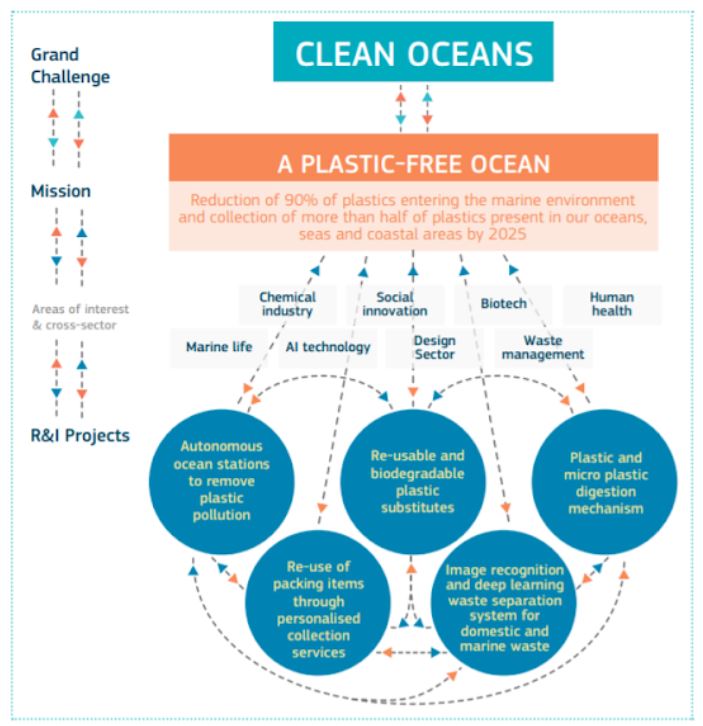Imagine a place where climate change, healthy population, food security and societal challenges of today’s world are truly being placed at the heart of policy and regulatory instruments, in a comprehensive and cross-sectoral approach.
Imagine a fund with millions of euros exclusively dedicated to address these challenges. Imagine the highest flexibility of action, and strong cooperation between the public sector, the private sector and civil society working together with a shared mission.
Imagine a region where all this exists already, on a local scale, and with powerful results.
This place is Europe, this fund is Horizon Europe, and this region is Northern Netherlands.
Mission-oriented innovation policies
The concept of mission-oriented innovation policies is at the centre of Horizon Europe. Mission-oriented innovation policies have the ambitious to foster disruptive and breakthrough innovations to respond to the 21st century social, environmental, and economic 'Grand Challenges' such as climate change and resource efficiency, demographic change, clean energy, inclusive societies, bioeconomy…
Professor Mariana Mazzucato popularised this concept in 2018, when she wrote a European Commission report titled Mission-oriented research & innovation in the European Union. The report makes strategic recommendations to policymakers to maximise the impact of the future EU Framework Programme for Research and Innovation through mission-oriented policy.
In the report, Mazzucato points out that missions should be selecting the following five criteria:
- Bold, inspirational with wide societal relevance. Missions should respond to the grand challenges of our society as a whole.
- A clear direction: targeted, measurable, and time bound. Missions need to be very clearly framed.
- Ambitious but with realistic research and innovation actions. The logical framework should be ensured: from global, cross-sectoral missions to very specific R&I projects.
- Cross-disciplinary, cross-sectoral, and cross-actor innovation. Missions should be framed to spark activities across, and among, multiple scientific disciplines (including social sciences and humanities), across different industrial sectors (e.g., transport, nutrition, health, and services), and different types of actors (public, private, third sector, and civil society organisations).
- Multiple, bottom-up solutions. Missions should not be achievable by a single development path or by a single technology, but by a set of complementary tools and projects.

Source: European Commission, 2018 - A Mission-oriented Approach for a Plastic Free Ocean
Horizon Europe
Horizon Europe is the next research and innovation framework program for the period 2021-2027. Horizon Europe has a budget of €97.6 billion, compared with €77 billion for Horizon 2020, making it the world most ambitious research and innovation funding programme. The framework programme is designed around three pillars:
- The Open Science pillar (€ 25.8 billion) supports researchers through fellowships and exchanges through the European Research Council and the Marie-Skłodowska-Curie actions.
- The Global challenges pillar (€ 52.7 billion) supports research relating to societal challenges, setting EU-wide missions with ambitious goals.
- The Open Innovation pillar (€ 13.5 billion) aims to make Europe a front runner in market-creating innovation. The European Innovation Council will offer a one-stop shop for high potential and breakthrough technologies and innovative companies with potential for scaling up.
Mission-oriented innovation policy at regional level: The Open Innovation Call
The concept of mission-oriented innovation offers regional governments the opportunity to experiment and create bold innovation policies and to learn from good practices from regions across the European Union.
The Open Innovation Call is a good example of regional mission-oriented policy tool.
The Northern Netherlands Provinces Alliance designed the Open Innovation Call thanks to the exchanges with BeyondEDP partners and experts. BeyondEDP aims to improve the RIS3 effectiveness through the management of the entrepreneurial discovery process (EDP). The Open Innovation Call is a programme that follows a mission-oriented innovation policy approach as it focuses on specific goals and regional challenges rather than on specific industrial sectors.
Indeed, the Open Innovation Call, which has a budget of €20 million for two years and can contribute to 40% of the total eligible costs, specifies strictly defined objectives but not the actions to reach those objectives. The selected projects must follow a collaborative approach, an integrated approach, generate business creation, have a lasting impact, and generate social significance. An interdisciplinary panel of external experts -from the private sector, the public sector, and universities — select the projects.
Luc Hulsman, programme manager at the Northern Netherlands Provinces Alliance, points out that 'with its inviting character the Open Innovation Call has filled in a gap left by other more traditional ERDF support instruments. As shown by the € 5 million of collaborative projects selected in the year of its introduction and more than € 10 million of initiatives expected to receive support soon, it is clear that the market has recognised the potential and possibilities of the Call. In addition, what is fascinating to see is that the Call truly helps project initiators and managing authorities to speak the same language, concentrating on the links between project and instrument objectives'.
In the Good practice expert opinion, Arnault Morisson, the thematic expert in research and innovation from the Interreg Europe Policy Leaning Platform emphasised that pursuing mission-oriented policies is “more relevant for regions that are ranked as Innovation Leaders in the Regional Innovation Scoreboard as those regions already have the critical mass of innovative actors and a well-functioning innovation ecosystem to support the next wave of disruptive innovations.” The Open Innovation Call offers regional policymakers an inspirational example on how to adapt the concept of mission-oriented innovations to the regional level.
Read the good practice online









